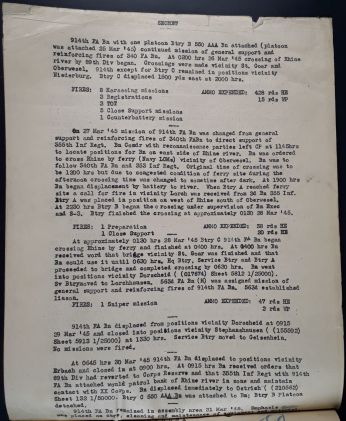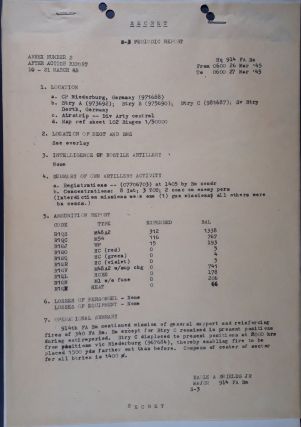On 26 March 1945, at 0200 hours, the 89th Infantry Division began crossing the Rhine on its march eastward. Imagine the coordination between the divisions, brigades, battalions, batteries to make this happen. As the crossing began, the 914th Field Artillery Battalion provided support to the 355th Infantry Regiment. The crossings were made near St. Goar and Oberwesel. My great uncle Irwin Carl, a corporal in the 914th Field Artillery Battalion, was there. He was one of 88 men in Battery C, positioned 1500 yards east of Niederburg.  [1]
[1]
How do I have such detail, down to his exact position? After Action Reports.[2]
After Action Reports typically comprise a narrative, plus S-3 and S-2 Reports and a Unit Journal. The “S” stands for “Staff.” The “3” refers to “Operations,” and the “2” to “Intelligence.” The After Action report is a high-level narrative, written in the weeks after events. It does not give names. For the 914th Field Artillery Battalion, the 10 – 31 March 1945 report was submitted on 1 April 1945.
Reading through the After Action report for 24 – 29 March provides much detail on the Battalion, and each Battery within the Battalion. It details the locations, and exact timing of movements of troops – even the type and amount of ammunition expended.
From reading the primary source material, I know that the Rhine crossing took days – the 914th Field Artillery Battalion, Battery C started crossing at 0130 hours on 28 March 1945 – 48 hours after the first troops headed across – and they finished at 0400 hours on 28 March 1945.
Primary source materials, and drilling down into the details, tells the soldiers’ stories. These documents helped inform this blog post:



Many thanks to Eric S. Van Slander, Archivist at National Archives, College Park, for his assistance locating a mislabeled box, without which this research would not be possible. See also:
- Know Your Records: WWII Army Unit Records from the National Archives Text Message Blog
- 89th Infantry Division of World War II
Next in the series… Liberation of Ohrdruf
[1] Allied Forces. Army Group, 1. E. S. & United States Army. Army Group, 1. H. (1944) HQ Twelfth Army Group situation map: Battle of the Bulge–France, Belgium, Netherlands, and Germany. 26 March 1945. [England?: Twelfth Army Group, to 1945] [Map] Retrieved from the Library of Congress, https://www.loc.gov/item/2001628569/, 26 March 2020.
[2] After Action reports are located in Record Group 407: Records of the Adjutant General’s Office, 1905 – 1981, World War II Operations Reports, 1940 – 1948. The 914th FA Bn: Entry (NM3) 427, File 389 – FA(914) – 0.3.
I would be interested in any information that I may bet about the 89th happenings on March 26, 1945, Worms, Germany. My brother was killed that day. My brother was PFC Raymond L. Vick. Thank you. Jean Brady
Hi Jean
Thanks for reading my blog. At the 89th website you can see information about the rosters (https://89infdivww2.org/home/list_v.htm) and located “Vick R. E., Pfc, 355thInf, Co A” Maybe the middle initial is a typo?
On 6 March 1945 the 89th began the crossing of the Rhine, between St. Goar and Oberwesel, about 100km from Worms. Maybe your brother was detached to a different unit, or he died of injuries in a field hospital?
If your family does not have a copy of your brother’s IDPF, there are instructions on how to obtain it at https://www.nationalww2museum.org/war/research-veteran.
The After Action reports I have copies of are not for your brothers unit within the 89th. Those papers would need to be researched in person at the National Archives in College Park, Maryland.
I hope this information is helpful.